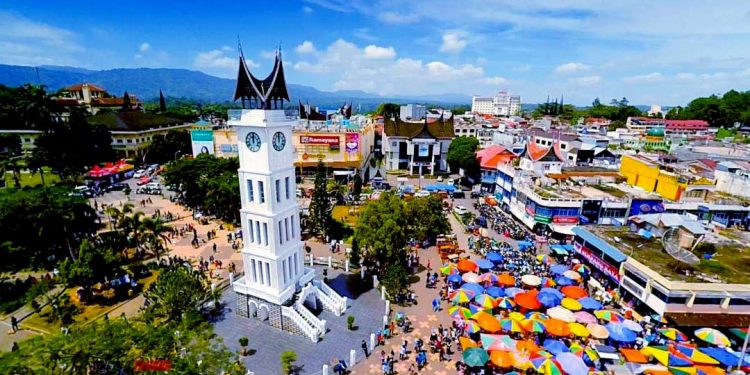Bukittinggi is a blissful city. The capital of Indonesia for a brief period in the 1940s during for independence. Every morning, Bukittinggi is covered in a mist that partially hides the surrounding Barisan Mountains and its steep valleys. Children walk slowly past the shops, where the doors are still closed, on their way to school. People venture outside their homes dressed in thick clothes, and groups of old men sit at street-side stalls with sarongs slung around their necks, like Europeans wearing shawls to keep out the snowflakes. But, of course, there is no snow in this city of almost 120,000 people, encased by tropical mountains.
Walk along the narrow city streets in the cool morning air, then sit alone on a garden bench at the edge of Sianok Canyon, a green valley – vast, meandering, and silent with a river flow along its middle.
While Bukittinggi today is much changed as hotels and shopping malls have sprung up, the canyon remains just as it appeared in Wakidi’s painting, a valley that will remain forever timeless.
Gradually, the mist begins to lift. Mount Singgalang and Mount Marapi show their form in the light of the morning sun. At the feet and on the lower slopes, small villages are still concealed by mist. In the past, these villages prospered as a result of world market demand for pepper, cloves, cinnamon, and acacia. After these spices lost their allure, the local communities began to farm vegetables such as chilies, celery, onions, carrots, and cauliflower. Once a week, the farmers’ hard-grown produce is taken by pickup trucks that travel in a convoy to cities in central Sumatra, Jambi, Pekanbaru, Batam, and even Singapore.
Situated 930m above sea level, Bukittinggi covers an area of only 25km2 or four percent of the total area of Jakarta. But despite its density and existence as an urban center since colonial times, the city never really gets too busy.
During the day, and even moreso on holidays, the streets come to life with the sound of car horns and the clatter of horses pulling two-wheeled carts, or bendi, carrying tourists. The Gadang Clock Tower, a relic of the colonial era, stands erect in the city center. Other points of interest include the Fort de Kock Dutch fortress, a network of underground bunkers built by the Japanese during the Second World War, racehorses grazing in the Bukik Ambacang, and the aroma of spices wafting out into the humid air from street stalls.
In the late afternoon, the city seems melancholic. In the orange twilight, Mount Singgalang and Mount Marapi stand proud, like giants protecting the city from impending disaster, and the monument of one of Indonesia’s founding fathers Mohammed (Bung) Hatta stands tall in the city park.
In the past, this city produced many well-known scholars and intellectuals. Bukittinggi had a ‘Kings School’ (Sekolah Raja). And the climate makes itpleasant and peaceful.
Located 100km from Padang, the provincial capital of West Sumatra, Bukittinggi has been a prime tourist destination since colonial times. The colonial government spent a large sum of money constructing a railway line connecting Padang to Bukittinggi at the end of the 19th century, and, at the same time, a track opened leading to the mining town of Sawahlunto. In 1902, the first train officially began operating, bringing tourists to Bukittinggi. Tickets cost 11 US$ per person, almost the monthly wage of laborers working on Sumatra’s east coast.
People sit inside the warmth of the street-side stalls, steaming food giving off a rich scent of spices. Looking for tasty food in Bukittinggi is like looking for sand on a beach: curried cow trotters (gulai tunjang), steamed fried chicken (ayam pop), duck with green chillies (itiak lado ijau), beef jerky (dendeng), fried eel (goreng belut), and many more, including rendang – the tender coconut-milk simmered beef dish that made CNN Travel’s list of the 50 most delicious foods in the world.



